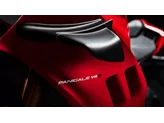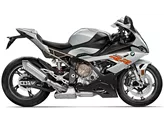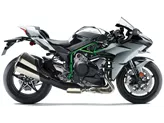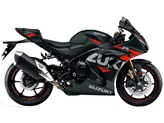Kawasaki Ninja ZX-10R 2016 vs. BMW S 1000 RR 2016

Kawasaki Ninja ZX-10R 2016

BMW S 1000 RR 2016
Overview - Kawasaki Ninja ZX-10R 2016 vs BMW S 1000 RR 2016
The Kawasaki Ninja ZX-10R and the BMW S 1000 RR are both highly regarded supersport motorcycles from the year 2016. While they share many similarities in terms of engine type, displacement, and chassis material, there are also some notable differences that set them apart.
In terms of engine specifications, the Kawasaki Ninja ZX-10R is equipped with a 998cc in-line four-cylinder engine, producing 200.1 horsepower and 114.3 Nm of torque. On the other hand, the BMW S 1000 RR features a slightly larger 999cc in-line four-cylinder engine, delivering 199 horsepower and 113 Nm of torque. Both bikes have a compression ratio of 13 and four cylinders, ensuring a powerful and smooth ride.
When it comes to suspension, the Kawasaki Ninja ZX-10R is equipped with an upside-down telescopic fork at the front and a swing arm at the rear. The BMW S 1000 RR, on the other hand, features a telescopic fork at the front and a swing arm at the rear. While both bikes offer a similar suspension setup, the BMW S 1000 RR is known for its comfortable seating position, allowing riders to enjoy long rides without discomfort.

Kawasaki Ninja ZX-10R 2016
In terms of braking, both motorcycles feature double disk brakes at the front. However, the Kawasaki Ninja ZX-10R utilizes radial and petal technology, which ensures excellent stopping power and heat dissipation. The BMW S 1000 RR, on the other hand, uses radial technology for its front brakes, providing precise and responsive braking performance.
In terms of dimensions and weights, both bikes have a front tire width of 120mm and a rear tire width of 190mm. They also share the same 17-inch front and rear tire diameters. The Kawasaki Ninja ZX-10R has a slightly shorter wheelbase of 1415mm compared to the BMW S 1000 RR's 1425mm. Additionally, the seat height of the Kawasaki Ninja ZX-10R is 813mm, while the BMW S 1000 RR has a seat height of 815mm. Both motorcycles have a fuel tank capacity of 17 liters, allowing for decent range on long rides.

BMW S 1000 RR 2016
In terms of strengths, the Kawasaki Ninja ZX-10R is praised for its great chassis geometry, high-quality chassis components, very good brakes, and extensive electronics. These features contribute to its exceptional handling and performance on the road. On the other hand, the BMW S 1000 RR is known for its very powerful engine, comfortable seating position, and excellent shift assistant, which allows for seamless gear changes.
However, the Kawasaki Ninja ZX-10R does have a weakness in its cockpit, which is not optimally readable. This may cause some inconvenience for riders who rely heavily on the information displayed on the instrument panel. On the other hand, the BMW S 1000 RR has been criticized for being somewhat sluggish in curves, which may affect its overall agility and maneuverability.
In conclusion, both the Kawasaki Ninja ZX-10R and the BMW S 1000 RR are exceptional supersport motorcycles from the year 2016. While the Kawasaki Ninja ZX-10R offers great chassis geometry, high-quality components, and advanced electronics, the BMW S 1000 RR stands out with its powerful engine, comfortable seating position, and smooth gear shifts. Riders looking for a bike with excellent handling and performance may prefer the Kawasaki Ninja ZX-10R, while those seeking a comfortable and powerful ride may lean towards the BMW S 1000 RR.
Technical Specifications Kawasaki Ninja ZX-10R 2016 compared to BMW S 1000 RR 2016
Pros and Cons in comparison
Pros and Cons in comparison
Kawasaki Ninja ZX-10R 2016

The ZX-10R Ninja has a certain majesty, at the first rollout it seems very stable, you have to force it into the radius a little. After a few laps, however, this effect is transformed into an incredible precision that allows a pinpoint line. The engine has now really become noticeably stronger and makes the Kawa an enormously good overall package that can please not only die-hard Kawasaki fans. The traction control on the Kawa is particularly positive and regulates very sensitively. You can even adjust the engine brake - so it certainly doesn't lack for electronic features. The ZX-10R is the only superbike that is already Euro4-compliant in 2016!
BMW S 1000 RR 2016

The S 1000 RR is the universal talent among the superbikes - you sit on it and feel comfortable straight away. Although it seems a bit nervous in comparison in terms of chassis and stability. However, it converts this into pleasantly easy handling and impresses with its enormous engine power. The front wheel is indeed particularly light and has to be calmed by the steering damper. An incredibly sporty and at the same time comfortable feature is the shift assistant for upshifting and downshifting - this brings calm to the chassis and you can fully concentrate on driving.
Price Comparison Avarage Market Price Kawasaki Ninja ZX-10R vs BMW S 1000 RR
There are a few key differences between a Kawasaki Ninja ZX-10R 2016 and a BMW S 1000 RR 2016. In terms of price, the actual average price of a Kawasaki Ninja ZX-10R 2016 is about 39% higher. A Kawasaki Ninja ZX-10R 2016 experiences a loss of 1,650 USD in one year and 1,600 USD in two years of ownership. This is offset by a loss of 10 USD and 470 USD for a BMW S 1000 RR 2016. Compared to BMW S 1000 RR 2016 there are less Kawasaki Ninja ZX-10R 2016 bikes available on the 1000PS.de Marketplace, specifically 4 compared to 7. It takes less time to sell a BMW S 1000 RR with 69 days compared to 100 days for the Kawasaki Ninja ZX-10R. Since model year 2005 1000PS.de editors have written 51 reviews for the Kawasaki Ninja ZX-10R and 135 reviews for the BMW S 1000 RR since model year 2010. The first review for the Kawasaki Ninja ZX-10R was published on 1/11/2004 and now has more than 2,900 views. This compares to more than 4,000 views for the first review on BMW S 1000 RR published on 4/16/2008.






















